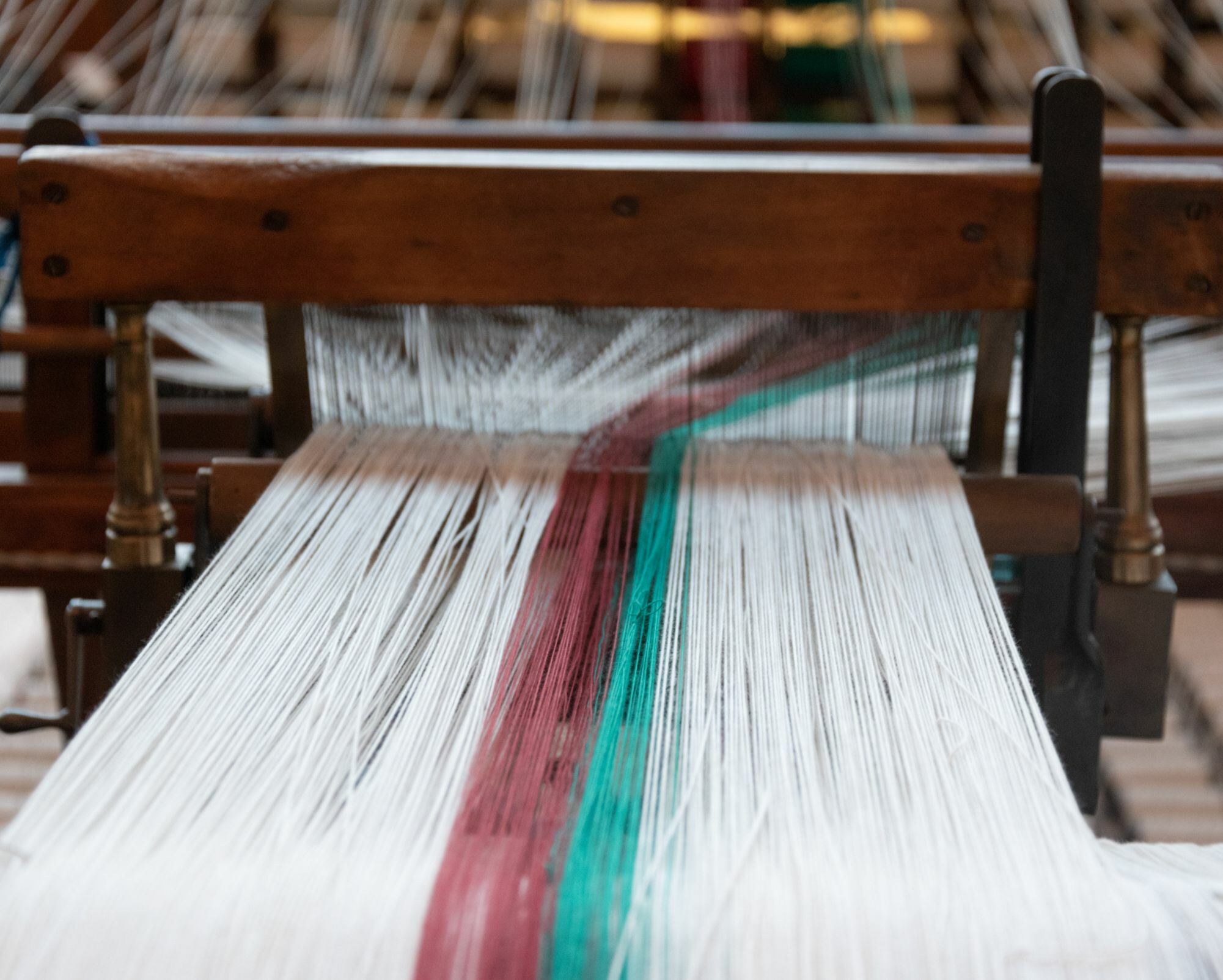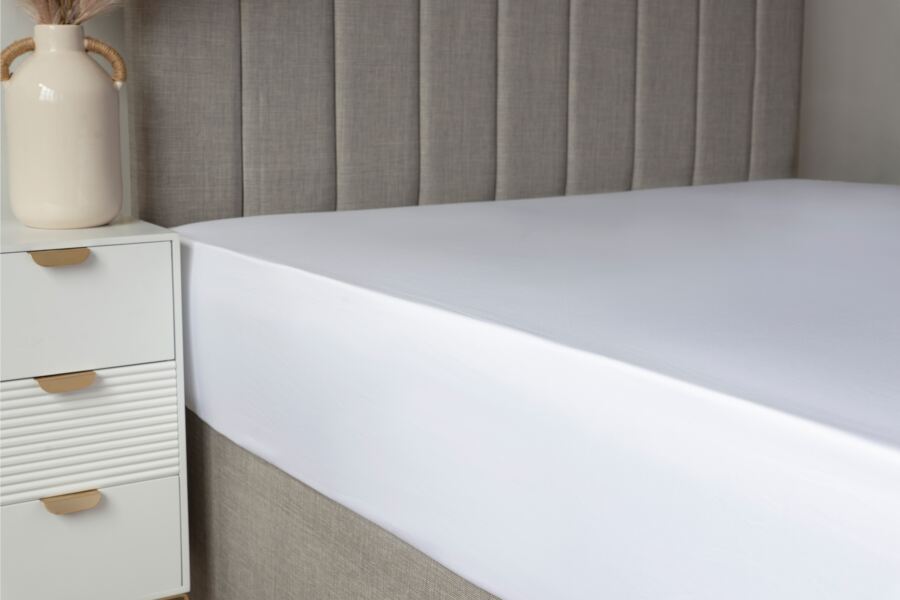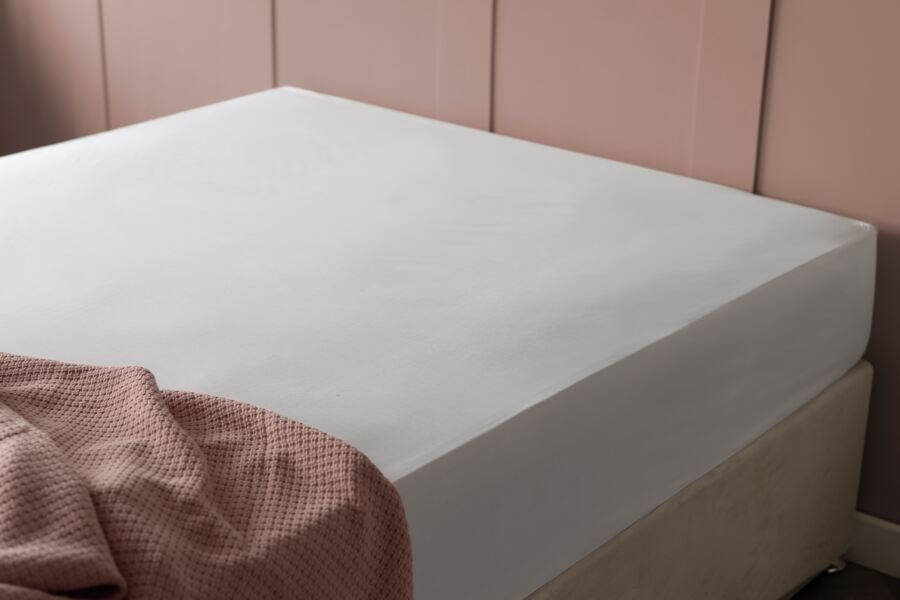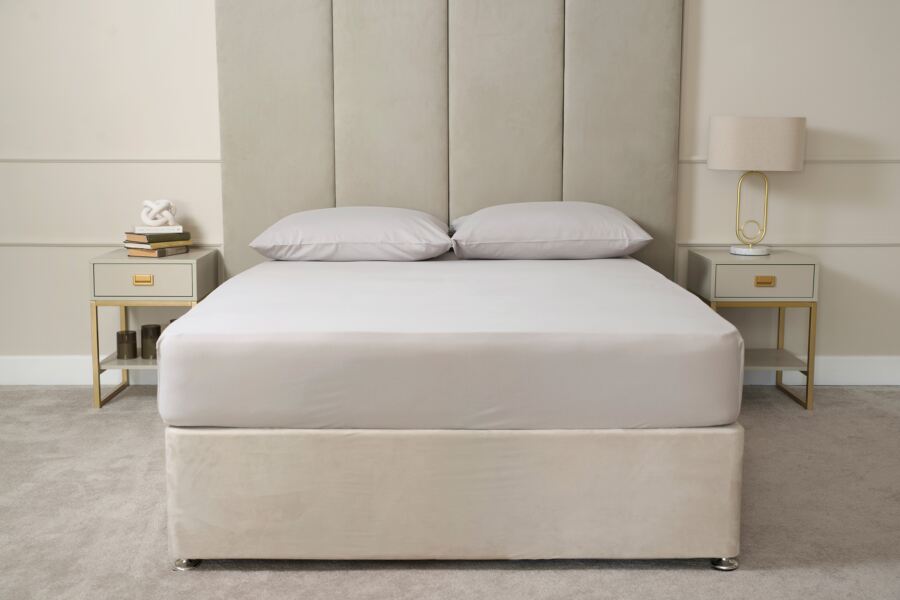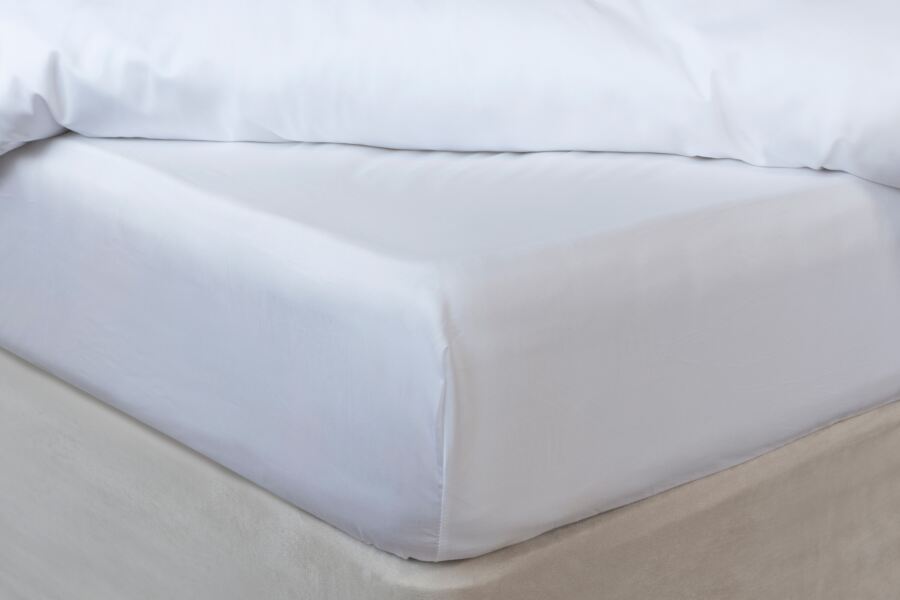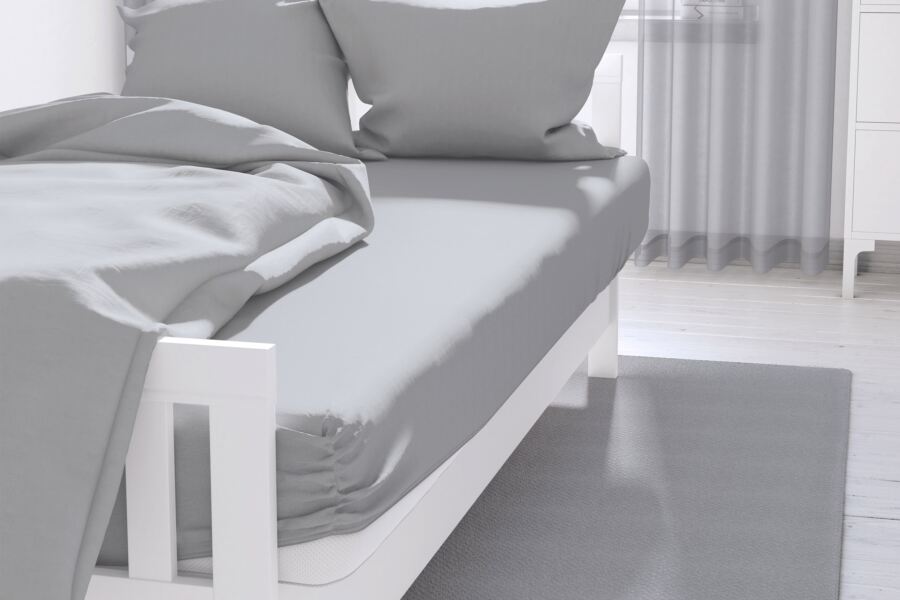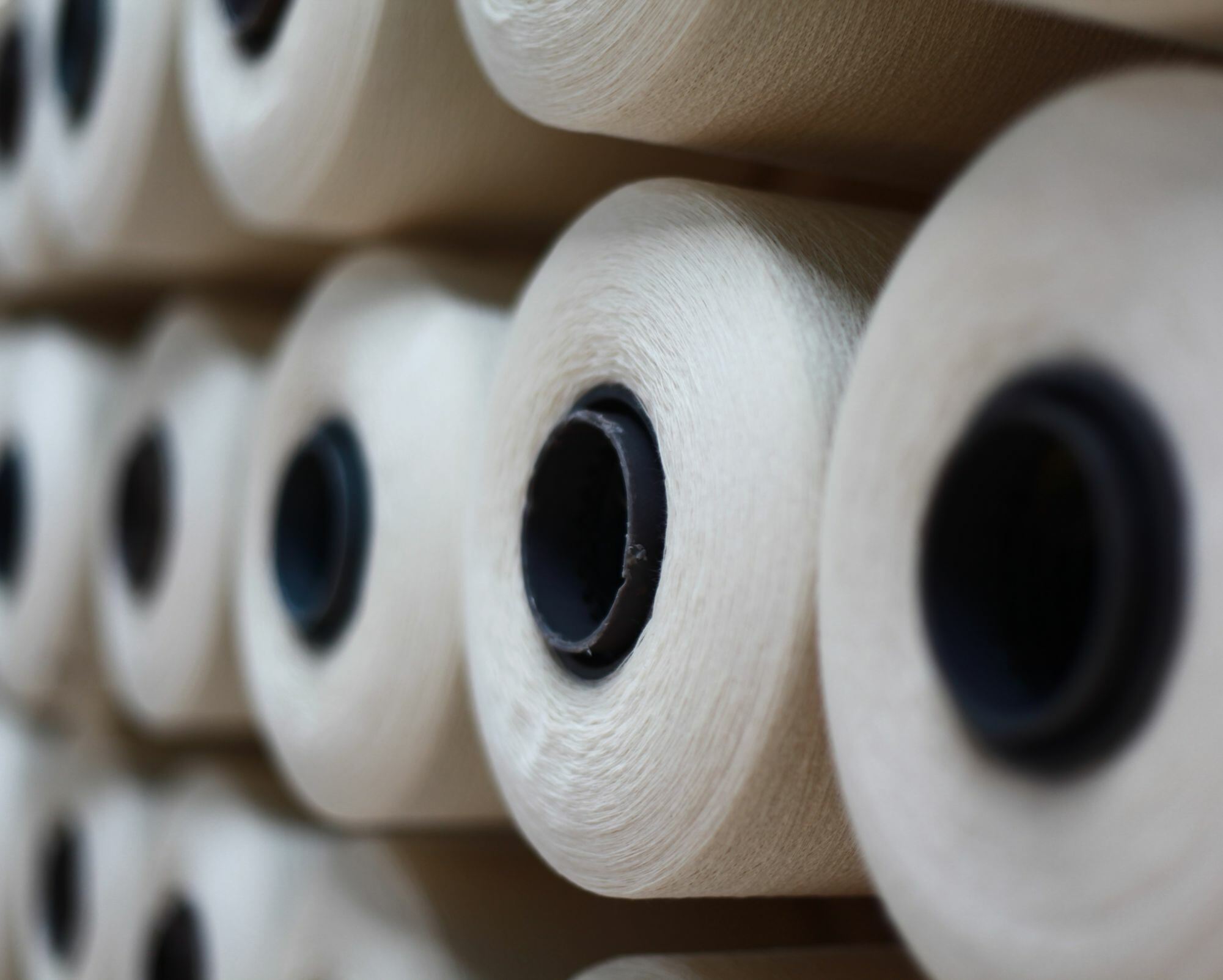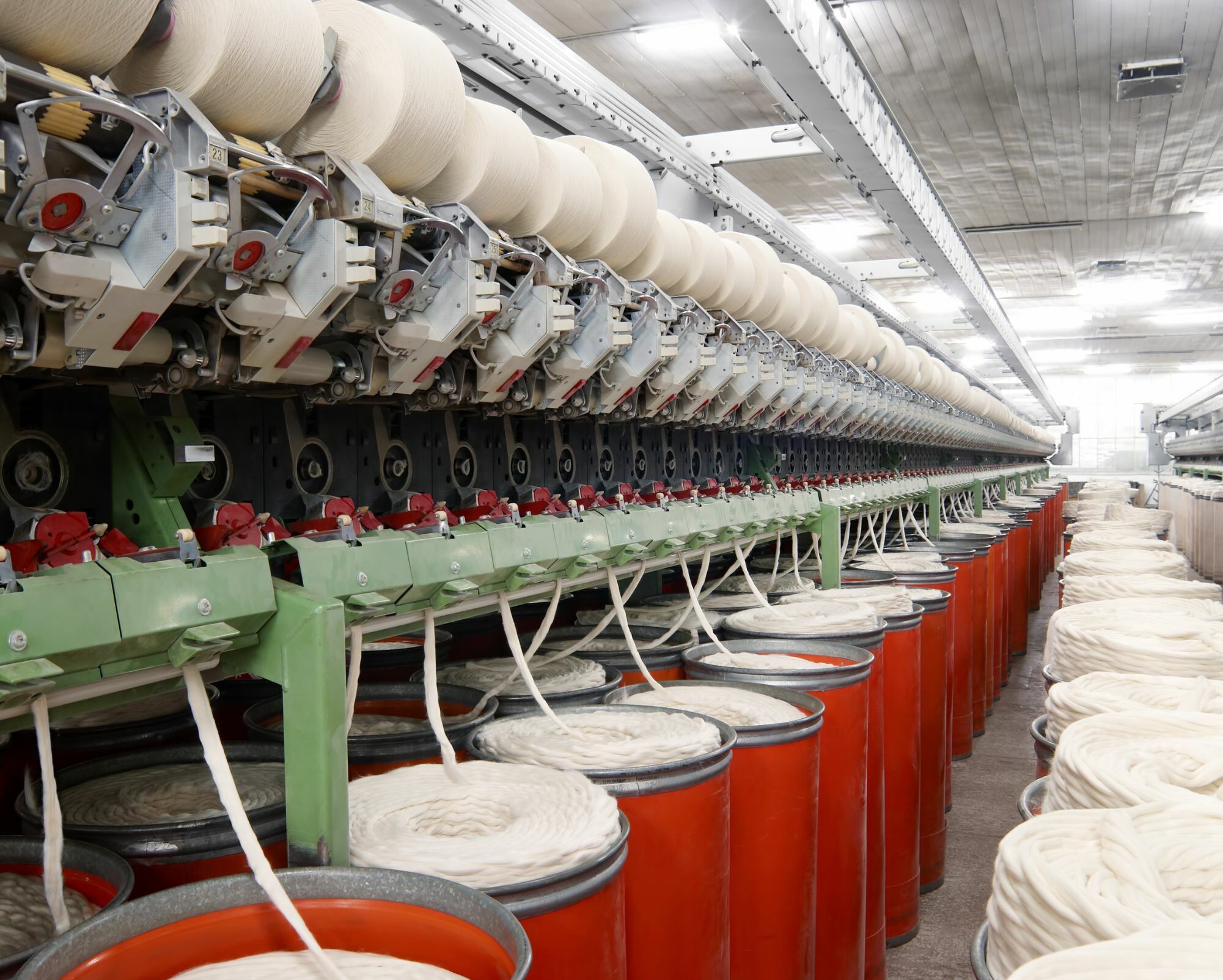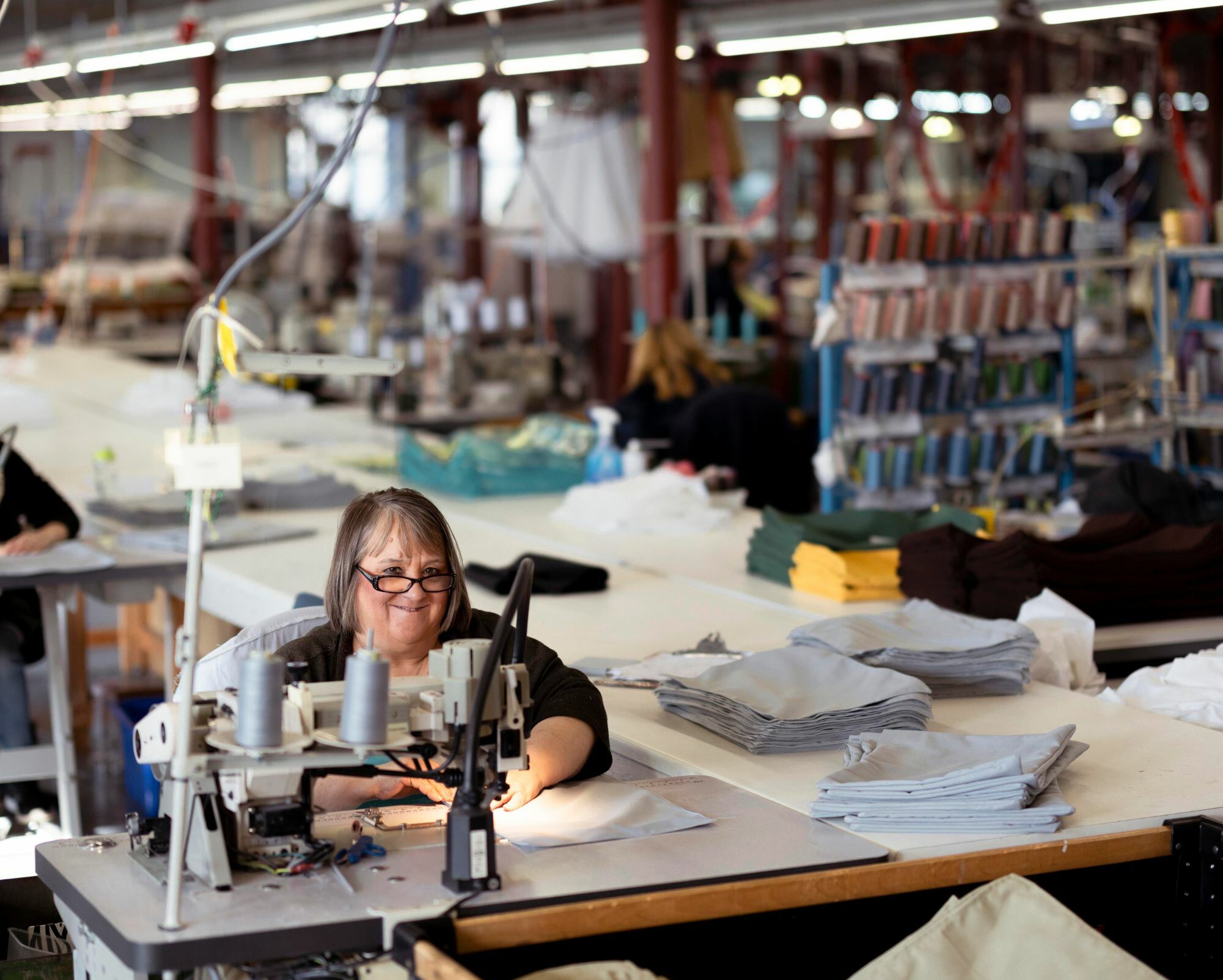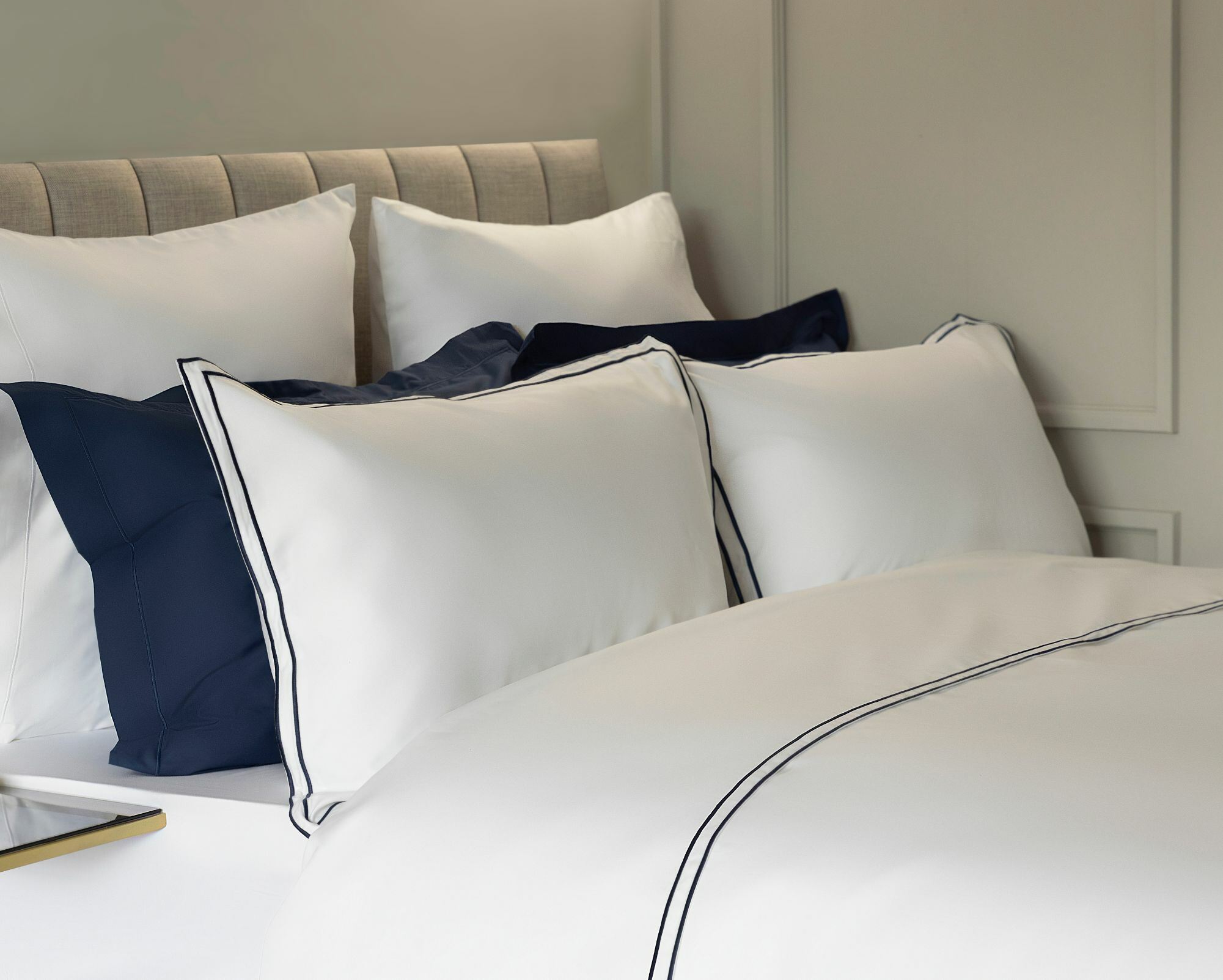Table of Contents
- What Is Thread Count?
- Does Thread Count Really Impact Bedding Quality?
- Is A Higher Thread Count Always Better?
- What Is A Good Thread Count For Sheets?
- What Thread Count Is The Softest?
- Thread Count And Fabric Weaves
- Debunking Common Myths About Thread Counts
- Other Factors To Consider When Buying The Right Bedding
- FAQs
What Is Thread Count?
If you've ever been shopping for new linens, you've probably come across the term 'thread count'. Many of us know (or rather, we've been told) that thread count is an indicator of how luxurious bedding is, or that a larger thread count means better quality. But what exactly does thread count mean?
Thread count refers to the number of threads woven into one square inch of fabric and considers both vertical and horizontal threads. These threads are also known as warp and weft threads, respectively. Thread count is a common metric or unit of measurement that is used to assess the density and tightness of a fabric's weave. In simpler terms, it refers to how densely the threads are woven into the fabric.
Although thread counts that are higher are usually associated with higher-quality sheets and bedding, they aren't the sole determining factor of fabric quality. Instead, a higher thread count generally suggests that the fabric is made from finer yarns. This is because thinner threads can be packed more tightly into a square inch of fabric compared to thicker yarns.
Since thinner threads can be packed more closely together, the resulting fabrics are often smoother in texture and have a softer feel. However, other factors that can affect the overall quality of the fabric include:
-
The quality of the fibres that are used
-
The number of plies, which are the strands of threads that are twisted together to form a single thread
-
The type of weave
-
The finishing processes that are applied to the fabric
How is thread count determined?
Now that you know what thread count is, how exactly do manufacturers determine what the thread count of your bed sheet set is? Well, this comes down to the number of vertical and horizontal threads woven into one square inch of fabric.
For example, if a fabric has 100 vertical, or warp, threads and 100 horizontal, or weft, threads per square inch of fabric, the total number of threads would be 200. Therefore, the fabric would have a thread count of 200. This also means that sheets with a high thread count have more threads going in both directions, which leaves less room for gaps as the weave is generally much tighter for high thread counts.
Does Thread Count Really Impact Bedding Quality?
A good thread count can impact the quality of your bedding in a number of ways. Still, it's important to remember that thread count isn't the only indicator of how luxurious your bedding will be. Therefore, no matter what your thread count is, you'll want to remember not to base your purchase off of thread count alone.
Here's how thread counts can potentially influence the overall quality of your bed linen:
Texture
Generally, higher thread counts are associated with a smoother and softer texture because of the fine yarns that are used in the fabric. This leads to a much more luxurious feel against your skin when you're in bed, which can lead to a better night's sleep and enhance your all-around comfort.
When it comes to textures, however, everyone has their own personal preference. For example, while some people may like the soft texture of silk, others may not enjoy the way it feels against their skin as they sleep. They may prefer a thicker, more substantial material or one that is less smooth. So when you're assessing your sheets, be sure to feel which ones are right for you.
Durability
Bedding with higher thread counts has a much tighter weave because of the number of threads used per square inch of fabric. Since the space between the threads is smaller, the weave prevents the threads from breaking or coming loose. In turn, there is less chance of your sheets ripping or tearing.
With higher thread counts, your bedding will be more resistant to general wear and tear and will last much longer than a standard low thread count sheet set.
It's important to remember that in some cases the difference in durability between moderately high and very high thread count sheets is minimal. In fact, you may not even notice a difference at all if you're comparing their durability based on thread count alone. You also need to consider the material and weave.
A good example to compare the durability of minimally different thread counts can be seen between Egyptian cotton 400 and 450 Pima cotton. Pima cotton is a more naturally durable material, which means that despite being almost identical to Egyptian cotton in thread count, it will still last a little longer.
Breathability
Don't be fooled by thread counts! There are some instances where manufacturers use multi-ply yarns to artificially 'bulk up' their thread counts (which we'll touch on more below). When this happens, the breathability of the fabric is reduced significantly. In turn, there is decreased airflow in the fabric and it may feel warmer.
If you're buying summer sheets or you live in a warmer area, you don't necessarily want thicker linen. These sheets with boosted thread counts can make you even hotter, more bothered and downright uncomfortable despite seeming luxurious since they boast high thread counts. While a high thread count can contribute to a certain level of comfort, you don't want to rely on this element alone.
Price
It's no secret that bed sheets with a larger thread count can come with a pretty hefty cost attached to them. This is mainly because a lot of people are under the misconception that a higher thread count alone means that you're getting top-quality sheets. However, this is simply not true! There are a ton of factors that go into high-quality bedding and the thread count is only one of them.
If you think about what thread count is, then it's easy to understand that one can easily amp up the listed thread count on bedding with any kind of thread or material. As long as the vertical and horizontal threads (of any material) are tightly woven into one square inch of fabric, you'll have a high thread count.
Unfortunately, there are some manufacturers who use this tactic to push up the price of their bed sheets. That's why it's important to consider all of the other factors that go into making sheets of higher quality.
Quality of the material
The quality of the material that is used in your sheets makes a huge difference to how it feels, its breathability, its comfort and your overall sleep experience. While thread count can impact how these materials feel when they've been woven together, a big part of having quality sheets is starting with the right material.
For example, long-staple cotton like Pima cotton is known for its amazing quality and luxurious textures. This is what makes it so sought-after for premium bedding. On the other hand, regular cotton (even with the same thread count) can offer a good sleeping experience but with a slightly different feel. No matter which bed sheets you choose, be sure to evaluate what materials they're made from.
Weave
There are a handful of different weave types that bed sheets usually have. While we'll get into all of the different types later on, it's important to note that the weave pattern can make a really big difference in the quality of your bedding.
A higher quality weave, combined with good manufacturing processes and attention to detail, usually leads to a more comfortable, durable and visually pleasing set of bed sheets. When a balanced weave is combined with well-constructed fabrics, you'll get an even more amazing product that feels like a dream!
Misleading marketing
When you're examining different bed sheets and wondering which one to buy, you'll want to watch out for misleading thread counts. Some manufacturers use techniques like using multi-ply yarns or counting each ply spun within a thread to artificially increase the thread count.
That means that you may think you're buying a higher quality product with a higher thread count, but instead, you're getting a mid- to low-quality product that has been made to seem more appealing. Plus, the use of low-quality threads can compromise the overall durability of the fabric, which can lead to a drop in quality as well.
Is A Higher Thread Count Always Better?
The easy answer to this question is no, a higher thread count isn't always better. As we've already mentioned, manufacturers can bulk up their thread count by using different tricks and techniques that could mislead their customers. However, there are still some instances where thread count doesn't really matter as much.
Thread count isn't a reliable measure of quality for certain materials like polyester (or polyester blends), linen, silk, flannel or even knit fabrics. Unlike cotton, where higher thread counts typically imply finer and softer fabrics, these materials have other properties that make the thread count almost irrelevant.
When thread count doesn't matter
Polyester and polyester blends are manufactured in a way that allows for super thin fibres. This means that the thread count of these materials is inflated beyond the normal scope of traditional thread counts.
These incredibly high thread counts also don't necessarily reflect how comfortable, soft or durable these materials will be. For example, a 1400 thread count polyester bedding set might not meet the standard as well as you'd expect. While polyester has benefits like strength, affordability and wrinkle resistance, it doesn't have the luxurious feel of natural materials like cotton.
Some other examples of these types of materials include silk and linen. Linen is known for its breathability and thickness, but it usually has a lower thread count. On the other hand, silk is fine and uses so many fibres that its quality is gauged by weight rather than thread count.
Lastly, materials like flannel and knits that are usually cotton-based aren't measured against thread count. Flannel sheets are sold based on fabric weight, and jersey-knit sheets have a completely different construction when compared to traditional woven sheets.
What Is A Good Thread Count For Sheets?
The best thread count for sheets largely depends on the material and weave (and, of course, personal preference). Generally, the most comfortable and best-quality sheets fall within a range from around 200 to 400, while others are better around 600 and beyond. While there is technically no one 'best' thread count for sheets, there are certain ranges that work for different types of bed sheets.
The most common thread count for sheets of different materials include:
-
Cotton bed sheets: When it comes to cotton, you'll want to pick a minimum thread count of around 200 for a softer feel and a better all-around sleep experience. This is because cotton is naturally soft, which means the materials are soft and plush without needing to pack the threads too tightly to produce quality sheets.
-
Egyptian cotton bed sheets: A good thread count for these cotton sheets sits between 300 and 600. However, some of these sheets have a much higher thread count and still retain their luxurious feel for improved sleep quality. A good example of this is our 1000 thread count Egyptian cotton range.
-
Pima cotton sheets: Pima cotton has much longer fibres than traditional cotton and is considered a 'long-staple cotton' like Egyptian. Like its Egyptian counterpart, the best thread count for these sheets would be between 300 and 600.
-
Sateen weave sheets: Much like Egyptian fabrics, a good thread count from 300 to 600 is ideal for sateen weave sheets.
-
Percale weave sheets: Percale weave sheets have a more traditional thread count that is extremely popular for everyday bedding. These sheets have a perfect thread count range of between 200 and 400.
-
Bamboo sheets: Bamboo sheets are their most comfortable and plush at a thread count from 300 to 500, so be sure to keep a discerning eye out the next time you buy bamboo bedding.
-
Linen sheets: Linens aren't usually measured by their thread count since the weave is much more open. This means that there are fewer vertical and horizontal threads woven into each square inch area of fabric, resulting in a much lower thread count than what you would usually expect. Generally, high-quality linens only have a thread count of between 80 and 140.
On the other hand, there are some materials that don't measure thread count. These materials include:
-
Silk: Silk is measured in momme rather than thread count. The most desirable range for silk would be between 17 and 22 momme.
-
Microfibre sheets: This fabric isn't measured against its thread count, either. Instead, it's measured in GSM or grams per square metre. A suitable range for microfibre sheets would be between 90 and 120 GSM.
-
Flannel sheets: Like microfibre sheets, flannel is also measured in grams per square metre. Since these are usually used as heavyweight sheets in colder weather, they should ideally be 170 GSM or more. However, there are lighter options available for sleepers who tend to run hot at night or who experience nasty night sweats.
-
Jersey knit sheets: Lastly, jersey knit sheets use grams per square metre as well. Since these sheets are made from cotton, they are slightly lighter than flannel and have an ideal gram per square metre of around 150.
Although thread count is an important factor in assessing the quality of your sheets, it's important to remember that lower thread counts, like those in the 200 range, are still great for a number of reasons. For example, the more open weave allows for great breathability, which can boost your sleep quality on hot summer nights.
However, it's best not to opt for any sheet set that has a thread count of 180 or less, since these may feel slightly rougher and impact your sleep quality more negatively.
What Thread Count Is The Softest?
By now, it's obvious that the softness of your sheet set isn't only based on high thread counts. You still need to consider factors like material and weave patterns to really make sure that your bedding is as comfortable as it can be. Softness is also a matter of personal preference since some enjoy softer sheets, while others like slightly stiffer sheets - especially when it comes to bottom or fitted sheets.
Of course, it wouldn't hurt to pick a notoriously soft material and choose the ideal thread count for sheets at the same time. This is probably why the most popular sheets among bedding aficionados are usually made of Egyptian cotton and range between a thread count of 200 and 600.
In fact, Egyptian cotton 200 thread count sheets are highly durable and affordable, meaning that you don't have to break the bank to improve your sleep quality. They're also higher quality than your standard 200 thread count cotton sheets. Another really great choice for hitting the perfect thread count sweet spot and still keeping costs relatively low is Egyptian cotton 400 thread count sheets.
Thread Count And Fabric Weaves
Certain weave types have their ideal ranges of thread count, so it's important to know the difference between them. This is because thread count and weave type also play a role in the feeling, appearance and general quality of your bedding.
The most common weave types are plain weave, percale and sateen. Let's take a closer look at each one to get a better idea of how this can affect the quality of your new bed sheets.
Plain weave
A plain weave describes a more traditional weaving pattern and can sometimes also be referred to as a simple or one-by-one weave. This is because it uses a one-over, one-under technique, which means that each weft or horizontal thread passes over and then under the warp or vertical thread in an alternating pattern.
Every time the warp and weft threads meet, they create a grid-like structure in the fabric and interlock for good durability. This is also why the plain weave is used as a foundational weave for other types of weaves when making fabric. It serves as a type of reference point for more intricate weaving patterns too.
Percale
The percale weave is woven fairly similarly to a plain weave but with a true thread count of around 200 or more per square inch of fabric. Usually, percale weave sheets look slightly flat and have a matte or semi-matte appearance to them. Since most percale weaves also use finer threads, the resulting bedding should typically have a slight lustre to them, which is what makes them look so magnificent.
Because the weave is slightly more open and usually has a thread count of around 200, percale sheets are generally more lightweight and breathable than other weaves, with a naturally high thread count.
Sateen
Sateen has a unique weaving pattern of one vertical thread for every four horizontal threads. This allows for a much tighter weave and, as a result, higher thread counts. Because the four horizontal threads are on the surface of the fabric, it also means that the fabric is slightly heavier than a standard percale weave.
Typically, sateen sheets have a silky smooth satin-like feel to them and are naturally more lustrous than other weaves. They also usually have a higher thread count for sheets that range between 300 and 600. This thread count is standard for this type of weave, so be sure to keep your eyes peeled when you're buying new bedding. You'll want to make sure that the weave type matches the thread count!
Debunking Common Myths About Thread Counts
Since as far back as we can remember, people who celebrate high-quality linens have made a pretty big deal about the thread count for sheets and other bedding. While it may be true that thread count has some impact on the way that your bedding feels and the quality of your linens, it's not the only factor that goes into quality sheets.
Over time, there have been certain myths and misconceptions that have sprouted about thread counts and what the best thread count is. To truly understand everything there is to know about thread count, it's essential to know what these myths are and why they are entirely false!
The most common myths about thread count include:
-
Only the feeling of the bedding matters, and a higher thread count means a better feel
-
The type of material that is used in your bedding doesn't matter, as long as it has a high thread count
-
If a fabric is listed as having a high thread count, it automatically means that the fabric is high quality
Only the feel of the bedding matters
When you're buying bedding that lists thread count as a measurement for quality, it's easy to mistake this as being the only important factor. Since a high thread count sheet has become synonymous with softness and a more luxurious sleeping experience, it's no wonder that people put more consideration into thread count than other elements.
However, as we've demonstrated above, thread count is only one of the factors you need to consider when you're choosing your bed sheets. In some cases, thread count has absolutely nothing to do with the feel of your bedding!
For example, when it comes to linen, many people enjoy the feel of linen sheets on their beds. However, these sheets have a significantly lower thread count than cotton. This doesn't mean that linen sheets are horribly rough or stiff. Instead, it just means that the thread count is less important when dealing with this type of material.
Additionally, some bedding with thread counts of 1000 or more can be pretty stiff. This is because there are more fibres packed into each square inch of fabric, which leaves less space for the fabric to move and drape. If you're looking for soft bedding, high thread counts aren't always going to meet your needs.
The type of material doesn't matter
Another common myth that we're here to squash is that the material you choose doesn't matter. As long as the thread count is high, the material is going to be of high quality, right? Wrong!
Not only do some manufacturers use multi-ply yarns to make it seem as if their fabrics have higher thread counts, but they also use underhanded tactics and count the number of threads differently. This means that they are packing thicker yarns into squares to essentially take up more space and make each square inch of the material seem more densely populated.
When they use thicker yarns, some materials may end up looking (and feeling) lumpy, bulky and generally uncomfortable. In turn, this can affect your sleep quality and overall sleep experience. While you may think you've bought sheets of high quality because they have a larger thread count, you may actually be paying for a sub-par product.
It's also important to remember that different materials feel different. There's even a difference between standard, Egyptian and Pima cotton! The weave, thread count and type of material that is used in your sheets will change the way they feel against your skin. For this reason, we always recommend feeling your bedding out for yourself before making a blind purchase based on the thread count.
The higher the thread count, the better the fabric is
We know that we may sound like a broken record here, but this is the biggest misunderstanding about thread count. Some 'lower-quality' kinds of cotton can be spun and made to seem like they have the best thread count without actually using premium, luxurious materials.
It's crucial to keep your eyes peeled for sly tactics that make thread counts for sheets seem more important than the type of material that is being used to weave the fabric. Below, we've listed the most important factors to consider (besides thread count) when you're buying new sheets. In these factors, we go into more detail about the type of material you want if you're looking for quality sheets.
Other Factors To Consider When Buying The Right Bedding
While it's not the main determinant of bedding, thread count is still important to an extent. You should always opt for a thread count that balances quality, comfort and breathability. A good thread count to pick for standard bedding is usually between 200 and 400. Besides thread count, you should always look out for:
Material
The type of material you pick can make a huge difference to the feel and comfort of your bedding. The most common materials that are available include cotton, silk, linen, bamboo and microfibre fabrics, which all have unique properties and purposes. For example, linen is great for breathability, while bamboo has moisture-wicking properties that make it perfect for the summer heat!
It's important that if you're picking a fabric that relies on thread count as a measurement, you must be sure to compare it against our guide above. It will ensure that you're getting great quality and picking a fabric you love.
On that note, you should always choose a material that aligns with your needs. Some materials need more maintenance, while others need less care and are easier to maintain. Similarly, some materials are warmer (which is great for when there's a chill in the air) and others are much better for hot sleepers.
Weave
The weave type is influenced by thread count. Typically, the higher the thread count is, the closer or tighter the weave will be. While this isn't true for all fabrics, it's a good rule of thumb when you're picking between different weave types.
The weave can also affect the texture and visual appearance of the fabric. Percale is usually crisp and matte, while sateen has more lustre and can be much smoother. Pick whichever one suits the tone and style of your bedroom, as well as one that feels the most comfortable to you.
Quality
High-quality bedding pretty much guarantees better sleep quality and is usually more durable than cheaper, low-quality sheets. When you're assessing options for your new bedding, be sure to look for well-constructed seams, tightly woven fabric and attention to detail in the stitching and overall construction.
Loose threads, big gaps in the fabric or extremely transparent fabrics are all common indicators of lower-quality sheets (within reason, of course).
Ideally, you'll want to buy your bedding from trusted, reputable brands that have made names for themselves thanks to their quality and construction. Most high-quality brands have more affordable styles and products, too, so you don't have to sacrifice your entire budget for some luxury bedding!
Breathability
Do you find yourself sweating a lot at night? Or maybe you just hate feeling hot and stuffy when you're all tucked in and trying to catch some shut-eye. Either way, breathability is an important factor when you're picking the right bedding. This is because it can affect your body temperature and temperature regulation while you sleep.
It may be best to have several sheet sets in your linen cupboard. At the very least, you should have one that's lightweight and ideal for the warmer months and one set that is thicker and more insulated for when the winter months come around.
Natural fibres like cotton and linen have much more breathability than flannels or jersey knits. If you're aiming for breathability, you'll want to choose one of these materials, which can help to prevent overheating and keep you cool and comfortable all night long.
Cost
Price is one of the most important factors to consider since you don't want to spend more than your budget allows on bedding. You'll also want to keep in mind that price doesn't always reflect quality. In some cases, you can get amazing bed sheets at an affordable price. To do this, you'll need to focus on the value of the product rather than just its price tag.
You may also want to remember that investing in high-quality bedding could be cheaper in the long run. This is because you won't need to replace your bedding as often if you purchase a strong, durable sheet set that is made from good materials.
Don't rush your decision, either. Take time to compare different brands, materials and options to find one that fits your budget without compromising too much on quality.
Allergies and skin sensitivities
For some of us, picking out a new bedding set isn't as easy as picking out the most aesthetically appealing ones. Instead, we need to consider whether the materials work for skin sensitivities and whether they're hypoallergenic.
Some hypoallergenic materials include microfibre and certain types of cotton, so be sure to read the product labels carefully. You don't want to purchase the wrong bedding, after all! You should also consider how the bedding feels against your skin. If the fabric is too thick or scratchy, you may end up irritating your skin unnecessarily.
For example, linen is an amazing and sought-after fabric - especially for keeping you cool. However, some linen may be slightly rougher than others and can cause rashes (particularly in summer when you tend to sweat more often). Instead, a light microfibre sheet may work better to keep your skin feeling good and boost your sleep quality.
FAQs
Is bedding with a higher thread count more expensive?
Bedding with a higher thread count tends to be more expensive. However, the cost of some of these bed sheets is also attributed to the cost of the materials that the manufacturer has used, the brand reputation and the craftsmanship of the sheets.
You can use the thread count for sheets as a benchmark for the price of your bedding, but it's also important to take other factors into account. You may find that there are slightly cheaper alternatives to certain linens that use the same (or better) materials and that have the same thread count as the other sheets.
What is the best thread count for keeping cool?
When it comes to choosing the best thread count for keeping you cool during the hot summer nights or warmer weather, you'll want to think about the thread count and the weave itself. A lower thread count usually has a more open weave, which means there is more airflow. More airflow means that the heat from your body can also dissipate when you sweat or when your body temperature is higher, making you feel cooler.
Some higher thread count sheets may have good breathability, though, depending on the material that's being used. For example, cotton is usually very breathable, no matter what thread count it has. Still, if you want the best chance of staying as cool as a cucumber, you may want to pick a thread count of between 200 and 400 for a lightweight sheet set.
What thread count do you really need?
Although many people may tell you to opt for a high thread count for sheets, this doesn't always mean that you're going to be comfortable. In fact, most people find that the best thread count for a comfortable night's sleep is around 200 to 400. At this range, you'll get a good blend of softness and durability. Additionally, your sheet set should be light enough to be breathable, which is great for most environments.
Are 1000 thread count sheets worth it?
While high thread count sheets (around 800 to 1000) may sound luxurious and opulent, they aren't always the best choice. They can sometimes be stiffer, made from less durable materials, or just downright too expensive. However, it's important to remember that your personal preference for the thread count of your sheets should always play a factor.
If you prefer higher thread counts, then you should go ahead and pick a material and thread count to match that. On the other hand, a 200 to 400 thread count for sheets is enough for most people to feel comfortable, and they're usually much more affordable than bedding with the 'best thread count'.
Which is better 200 or 400 thread count?
Choosing the best thread count between 200 and 400 will really depend on what you prize when it comes to sleep quality. If you want slightly more breathable sheets, then 200 should work perfectly. But if you want something slightly more durable and potentially smoother against your skin, 400 would be a great choice.
Just remember that no matter what you pick, you should always look at the 'big picture'. Consider all of the factors that make high-quality sheets and you'll be on your way to having an amazing night's sleep in no time.
References
http://www.truthaboutthreadcount.com/other-factors/weave-type.html
https://www.goodhousekeeping.com/home-products/a27494227/best-thread-counts-for-sheets/
https://www.beddable.co.uk/blogs/advice/what-is-thread-count
https://www.pillowguy.com/blogs/bedding/3-thread-count-myths-you-need-to-know
https://www.sleepfoundation.org/best-sheets/best-thread-count-for-sheets
https://www.goodhousekeeping.com/home-products/best-sheets/a45102/bed-sheets-buying-guide/
https://www.masterclass.com/articles/types-of-bedding

